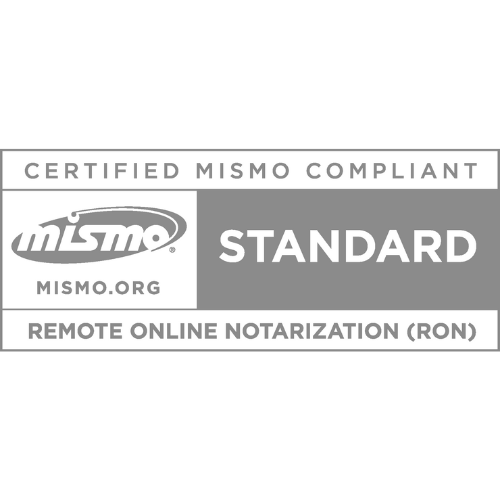Disclaimer: This blog post is for informational purposes only and does not constitute legal advice. Please consult an attorney for guidance on specific laws regarding Remote Online Notarization (RON), digital signatures, and related legal matters. As laws concerning RON and notarization are subject to frequent changes, it is advisable to verify current regulations with your local government.
If you’ve managed FHA loan modifications, you know the process can feel like a juggling act: tracking down borrowers for signatures, coordinating notaries, waiting on documents to return, and dealing with delays that can stretch for weeks.
Remote Online Notarization (RON) offers a digital, borrower-friendly way to handle loan mod notarizations that can help servicers and lenders streamline workflows while giving borrowers more flexibility and control.
In this article, you’ll learn about the traditional challenges that make FHA loan modifications time-consuming and costly, how RON technology can help address these pain points, and what you need to know about implementing RON in your loan modification processes.
Important Legal Notice: RON laws vary significantly from state to state, and this article is for informational purposes only. It’s essential to review applicable laws and consult with legal counsel before implementing RON for your FHA loan modification processes. Some states may have restrictions or specific requirements that could impact RON implementation.
The Traditional Challenge with FHA Loan Modifications
The current landscape of FHA loan modifications presents a complex web of operational challenges that can significantly impact both servicers and borrowers. Let’s break down these pain points to understand why modernization through RON has become increasingly necessary.
Scheduling Coordination Challenges
Traditional loan modification processes often require multiple parties to align their schedules: borrowers, notaries, and servicer representatives. Picture this: a borrower facing financial hardship may be working multiple jobs, dealing with irregular schedules, or managing family crises that make it difficult to commit to fixed appointment times. Mobile notaries, while helpful, often have limited availability and may charge higher rates for evening or weekend appointments. This scheduling coordination can extend the modification timeline by days or even weeks, particularly when appointments need to be rescheduled multiple times.
Geographic and Transportation Barriers
Many borrowers live in rural or underserved areas where notary services are scarce or expensive. Others may lack reliable transportation, especially those experiencing financial distress. This geographic challenge becomes particularly tough when borrowers have relocated due to job loss or other financial circumstances but still need to execute modification documents. The requirement for in-person notarization can create genuine hardship for borrowers who are already struggling financially.
Document Handling and Mail Delays
The traditional process involves multiple rounds of document shipping, creating numerous opportunities for delays and errors. Documents must be prepared, mailed to borrowers, reviewed, signed with a notary present, and then returned to the servicer. Each step introduces potential delays: mail delivery issues, document review time, notary scheduling, and return shipping. During peak seasons or in areas with postal service challenges, these delays can add considerable time to the process. It’s not uncommon for a simple mail delay to throw off an entire modification timeline, stretching execution to 15–21 days or even longer.
Error Correction and Re-execution Challenges
When errors are discovered after documents have been notarized and returned, the entire cycle often needs to begin again. A single missed checkbox, incorrect date, or document revision can trigger a complete restart of the notarization process. This means new documents must be prepared, shipped, scheduled for notarization, and returned, often adding significant time to an already lengthy process. For borrowers on tight timelines to avoid foreclosure, these delays can be particularly stressful.
Cost Accumulation and Resource Strain
The traditional process generates significant costs that compound over time. Overnight shipping fees, mobile notary charges, re-execution expenses, and internal processing costs can add substantial amounts per modification. For servicers handling hundreds or thousands of modifications annually, these costs represent a considerable operational burden. Independent mortgage banks (IMBs) using warehouse lines face additional float costs as capital remains tied up during extended modification timelines.
Borrower Stress and Abandonment Risk
The complexity and delays inherent in traditional processes can overwhelm borrowers who are already dealing with financial distress. The recent surge in FHA loan modifications due to the current rate environment has created additional pressure on both borrowers and servicers to execute modification packages quickly. Some borrowers may abandon the modification process entirely due to scheduling difficulties, transportation challenges, or frustration with delays. This abandonment doesn’t just fail to serve the borrower’s needs, it also represents wasted resources for the servicer and may increase the likelihood of foreclosure proceedings. When you’re already stressed about your finances, the last thing you want is a complicated paperwork process that seems to drag on forever.
How Remote Online Notarization Helps FHA Loan Mods
RON technology addresses each of the traditional challenges we just discussed while introducing new efficiencies and transparency that can transform the loan modification experience for both servicers and borrowers. Here’s how it works in practice:
1. Accelerated Execution Timelines
RON can help compress modification timelines from the typical timeframes to considerably shorter periods in optimal scenarios. This acceleration occurs because borrowers can review documents digitally ahead of time, allowing them to identify any errors in the documents. Once documents are ready, borrowers can often schedule notarization sessions within days, compared to the week or more typically required for traditional notary scheduling.
The immediate availability of completed documents after RON sessions helps eliminate return shipping delays entirely. Servicers receive executed documents within minutes of completion, allowing them to begin processing immediately. This speed can be particularly valuable when borrowers are facing tight deadlines related to foreclosure timelines or other loss mitigation requirements.
For IMBs utilizing warehouse lines, faster execution may translate to reduced float costs. When a modification that traditionally took several weeks can be completed in a shorter timeframe, the capital efficiency improvement can be substantial across a portfolio of modifications. This efficiency gain may also allow servicers to handle higher volumes of modifications without proportionally increasing staff or processing resources.
State Law Considerations and Promissory Note Requirements: RON availability and requirements vary by state, so it’s important to consult with legal counsel to understand how RON laws in your operating states may impact timeline expectations.
If a promissory note is part of the loan modification package, unless an eNote is used, a traditional promissory note may still need to be signed in ink in order to comply with negotiable instruments laws. These notes may not require notarization.
2. Enhanced Borrower Accessibility and Convenience
RON eliminates geographic barriers by allowing borrowers to complete notarizations from any location with internet access. This is particularly valuable for borrowers in rural areas, those without reliable transportation, or individuals who have relocated but still need to execute modification documents. Borrowers can participate in RON sessions from their homes, offices, or any private location that meets the technical requirements.
The scheduling flexibility of RON extends beyond traditional business hours. Many RON platforms offer evening and weekend availability, accommodating borrowers who work during standard business hours or have other scheduling constraints. This flexibility can significantly reduce the time required to coordinate all parties and move the modification process forward.
Document preparation and review become more efficient with RON platforms that allow borrowers to access and review documents in advance of the notarization session. This pre-review capability helps ensure borrowers are prepared and can address questions before the formal notarization, reducing the likelihood of delays or the need for additional sessions.
3. Cost Reduction Opportunities
RON can help reduce numerous traditional costs associated with loan modifications. Overnight shipping expenses are eliminated entirely. Mobile notary fees are typically replaced by RON session fees. The elimination of re-execution shipping costs when errors are discovered can save additional amounts per modification.
Beyond direct cost savings, RON may reduce internal processing costs by streamlining workflows. Staff time previously spent coordinating shipping, tracking documents, and managing notary schedules can be redirected to other productive activities. The immediate availability of executed documents helps reduce the administrative burden of tracking document status and following up on delayed returns.
Error correction often becomes more cost-effective with RON. When document revisions are needed, borrowers can often re-execute corrections within days rather than weeks, helping eliminate the full cycle of traditional re-execution costs. This efficiency in error correction can help prevent minor issues from becoming major delays and expenses.
4. Supporting Loss Mitigation Outcomes
The speed and efficiency of RON can help support loss mitigation objectives by helping borrowers avoid additional delinquency and related fees. When modifications are executed more quickly, borrowers may avoid additional late fees, attorney fees, or other costs that can accumulate during extended modification processes. This financial benefit can enhance the overall effectiveness of the loss mitigation effort.
Faster modification completion may allow servicers to provide resolution to borrowers more quickly, potentially supporting homeownership preservation in situations where traditional timelines might have resulted in foreclosure proceedings. The improved timeline can also help servicers meet investor guidelines related to loss mitigation timeframes.
RON’s reliability and reduced risk of execution delays can help servicers better manage their loss mitigation pipelines and may provide more predictable outcomes for borrowers. This predictability can be particularly valuable when coordinating with other loss mitigation activities or when borrowers are managing multiple financial obligations.
Legal Consultation Note: Loss mitigation requirements and timelines can vary by jurisdiction and investor. It’s advisable to consult with legal counsel to understand how RON implementation and the use of e-signatures may align with your specific loss mitigation obligations.
5. Operational Efficiency and Scalability
RON platforms often provide enhanced tracking and audit capabilities compared to traditional processes. Digital records of notarization sessions, borrower identity verification, and document execution can create comprehensive audit trails that may support quality assurance processes. These digital records are often more accessible and organized than traditional paper-based documentation.
The scalability of RON can allow servicers to handle volume fluctuations more efficiently. During periods of high modification activity, RON capacity can often be expanded more easily than traditional notary resources. This scalability may help servicers maintain consistent service levels even during peak demand periods.
Integration capabilities with existing loan servicing systems can help enhance operational efficiency. Many RON platforms offer APIs and integration options that allow executed documents to flow directly into loan files and servicing systems, potentially reducing manual data entry and processing time.
Borrower Experience: A Competitive Differentiator
Many borrowers appreciate the transparency and control that RON provides during the modification process. Rather than waiting for a notary or traveling to an office, borrowers can complete notarizations at home, on their schedule. This experience may help strengthen trust and satisfaction during what can often be a stressful time for the borrower.
The digital nature of RON also provides borrowers with immediate access to their completed documents, eliminating uncertainty about document status and providing peace of mind that their modification is moving forward. This transparency can help reduce borrower anxiety and improve overall satisfaction with the modification process. When you’re dealing with financial stress, knowing exactly where you stand in the process can make a real difference.
Case Example: RON Implementation Success
A mid-sized independent mortgage bank was struggling with their FHA loan modification timelines during a surge in modification requests driven by the current rate environment. Their traditional process, which relied heavily on mail delivery and in-person notarization, was taking an average of 19 days to complete. Mailing delays, particularly during busy seasons and in rural areas, were often stretching timelines to 21 days or longer.
Both borrowers and servicers were facing significant friction in executing modification packages quickly. Borrowers were frustrated with the lengthy process during an already stressful financial situation, while the lender was dealing with increased warehouse line costs and resource strain from the high volume of modifications.
After implementing RON for their FHA loan modifications, the lender saw their average execution time drop to just 8 days. This dramatic reduction helped decrease their warehouse line carrying costs and allowed them to process modifications more efficiently during peak demand periods. Perhaps most importantly, borrowers reported higher satisfaction with the streamlined process, and the abandonment rate for modifications decreased significantly.
The implementation particularly helped during the modification surge, as RON capacity could be scaled more easily than traditional notary resources, allowing the servicer to maintain consistent service levels even with increased volume.
A Note on Implementation
While RON offers potential advantages for FHA loan modifications, it’s essential to recognize that RON laws vary significantly across states and may impact how and where RON can be used. Some states have specific requirements, restrictions, or prohibitions that could affect RON implementation. It’s important to evaluate the legal and operational considerations within your lending footprint and consult with legal counsel before updating your processes.
Specific Legal and Technological Considerations: States may have different requirements for RON, including notary licensing, technology standards, record retention, and borrower identity verification. What works in one state may not be permissible in another.
Promissory notes have specific rules because they are negotiable instruments; eNotes may be a viable option, but check to see if your promissory note requires traditional signatures.
Implementation should also consider borrower technology access and comfort levels. While RON can provide significant benefits, servicers should maintain traditional options for borrowers who may not be comfortable with or have access to the technology required for RON sessions.
Final Thoughts
Modernizing FHA loan modifications with Remote Online Notarization can help servicers and lenders improve timelines, support borrower flexibility, and reduce unnecessary expenses tied to traditional notarization workflows. As more borrowers seek digital-first experiences, RON may become an important tool in your servicing and loss mitigation toolkit.
Important Reminder: Before implementing RON for FHA loan modifications, consult with legal counsel familiar with the RON and esignature laws in your operating states..
If you’re exploring ways to streamline your FHA loan modification processes while offering borrowers a modern signing experience, RON may be worth considering. The combination of potential operational efficiency, cost reduction opportunities, and improved borrower experience makes RON a compelling option for forward-thinking servicers looking to modernize their loan modification processes.






 Your Privacy Choices
Your Privacy Choices


